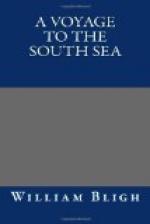Thursday 4.
This forenoon, having a pleasant breeze at north-west, we weighed anchor and sailed out of Adventure Bay. At noon the southernmost part of Maria’s Isles bore north 52 degrees east, about five leagues distant; Penguin Island south 86 degrees west; and Cape Frederick Henry north 65 degrees west. In this position we had soundings at 57 fathoms, a sandy bottom. Latitude observed 43 degrees 22 minutes south.
The southern part of Maria’s Islands lie in latitude 43 degrees 16 minutes south. The country is not in general woody, but in some of the interior parts there appeared great abundance. Among these islands I have no doubt of there being many convenient places for shipping. On the east side in latitude 42 degrees 42 minutes south and longitude 148 degrees 24 minutes east in July, 1789, Captain Cox of the Mercury found a convenient and secure harbour from all winds which he named Oyster Bay. Here he found wood, water, and fish in great abundance. It has two outlets and lies north, a little easterly, distant 34 miles from the south-easternmost island, or point, seen from Adventure Bay.
Adventure Bay is a convenient and safe place for any number of ships to take in wood and water during the summer months: but in the winter, when the southerly winds are strong, the surf, on all parts of the shore, makes the landing exceedingly troublesome. The bay of Frederick Henry may perhaps be found preferable, as it appears to be equally easy of access. The soundings in Adventure Bay are very regular: near the west shore are some patches of weed but no shoal or danger, the depth on them being from five to nine fathoms.
CHAPTER 5.
Rocky Islands discovered. See the Island Maitea and arrive at Otaheite. Ship crowded by the Natives.
1788. September.
Being clear of the land we steered towards the east-south-east, it being my intention to pass to the southward of New Zealand, as I expected in that route to meet with constant westerly winds; in which however I was disappointed, for they proved variable and frequently from the eastward blowing strong, with thick misty weather. The thermometer varied from 41 to 46 degrees.
Sunday 14.
On the 14th at noon we were in 49 degrees 24 minutes south latitude and in 168 degrees 3 minutes east longitude, which is on the same meridian with the south end of New Zealand. We altered our course, steering to the northward of east, and frequently saw rock-weed which I supposed to have drifted from New Zealand. The sea now became rougher from our being exposed to a long swell which came from the north-east.
Friday 19.




